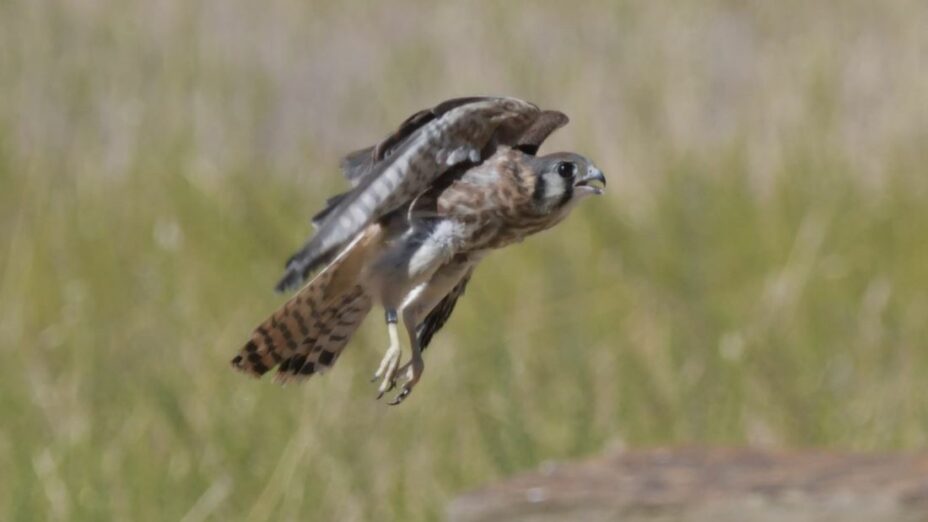
Small, adaptable, and powerful, the American kestrel is North America’s smallest raptor; it can be spotted soaring through the air or lying in wait in the trees as it hunts for insects and small mammals.
But it’s at risk; over recent decades, more than half of all kestrels in the US have disappeared.
We’ve been taking action to protect Mount Diablo’s at-risk kestrel population and working to help understand the causes of their population decline.
To date, through our release and nesting box programs, we’ve helped at least 121 kestrels survive and thrive over the four years we’ve been working with this species. This year alone, we released seven kestrels and have observed 24 inhabiting the nest boxes we placed across Mount Diablo.
The Release
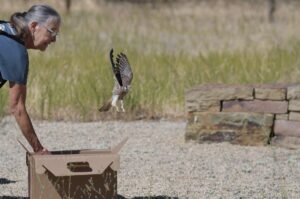
A kestrel fledgling launches into the air at Curry Canyon Ranch. Photo by Sean Burke
On a warm July afternoon, the kestrel fledglings arrived at Curry Canyon Ranch for a monumental occasion in their lives. They were to be released into the wild, free at last after months of rehabilitation.
We were joined by Wilton Rancheria from Elk Grove and the Lindsay Wildlife Experience, with raptor rehabilitation specialist Sherrill Cook.
Seven kestrels were released at Curry Canyon Ranch that day, immediately launching out of their boxes, and taking flight over the slopes of Mount Diablo.
They were all fledglings, and without this help, they would not have made it into the population at all. This is their first year, and actually, first months on this planet.
Some of these kestrels may potentially nest on our lands, in the nest boxes that we’ve placed on and around Mount Diablo over the years.
Placing Nesting Boxes: A Strategic Undertaking
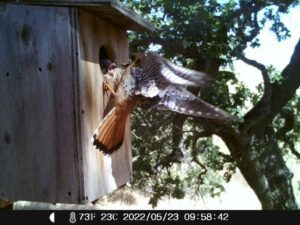
Kestrels use one of Save Mount Diablo’s nesting boxes.
Our kestrel boxes can’t be placed just anywhere. Kestrels can be picky with their nesting locations; they need a place high enough to be safe from predators and near open grassy habitat where the kestrels can hunt for food.
Additionally, the sun must be considered when placing these boxes. The boxes must face towards the east so that they warm up more quickly when the sun rises.
Since the start of this program, we’ve determined that 75 percent of the boxes that we’ve monitored have been utilized.
Over the years, our game cameras have captured images of important moments for the kestrels raised in these boxes. We’ve seen their parents bringing an assortment of food (including a king snake at one point) and their first flights as they take off from atop the boxes.
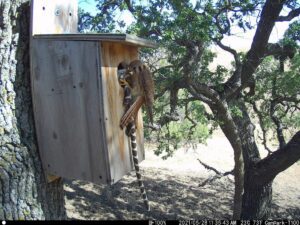
Our game cameras have captured images of kestrels enjoying a variety of prey, including this king snake!
These boxes provide a safe habitat for these raptors to nest in that is crucial for their survival.
Many of the rehabilitated kestrels that we released in Curry Canyon this year needed care in the first place because of a lack of safe nesting locations in the East Bay. Local kestrels have been known to nest in metal tubes, which overheat in the summer.
Why Is the Kestrel Population Declining?
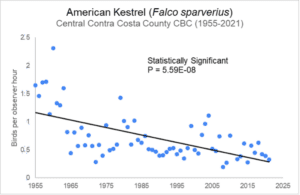
Graph courtesy of Floyd McCluhan
Habitat loss is potentially a major contributor to the kestrels’ population decline—their population has decreased by 68 percent in the state of California since 1978.
Of course, habitat loss isn’t the only thing affecting this species. The problem is compounded by multiple complex factors including pesticide use, loss of insect populations, and predation from other species, particularly Cooper’s hawks.
Supporting and restoring the declining kestrel population is one of the many reasons that it’s so important to protect Mount Diablo’s grasslands from development.
The Bay Area’s grasslands are prime hunting territory for kestrels and the many other birds of prey that can be seen soaring over Mount Diablo’s hills; without grasslands, many kestrels could perish.

